Dayton declares state of emergency over bird flu
Go Deeper.
Create an account or log in to save stories.
Like this?
Thanks for liking this story! We have added it to a list of your favorite stories.

Updated: 6 p.m. | Posted: 2:50 p.m.
Gov. Mark Dayton on Thursday declared a peacetime state of emergency to strengthen the state's response to an unprecedented avian influenza outbreak.
The governor's order came after a preliminary test showed that a strain of avian flu has struck a Minnesota chicken flock for the first time this year.
Turn Up Your Support
MPR News helps you turn down the noise and build shared understanding. Turn up your support for this public resource and keep trusted journalism accessible to all.
In just seven weeks, the disease has spread to 46 Minnesota farms wiping out 2.6 million birds. The emergency order clarifies the roles of state agencies as they fight to contain the lethal bird flu outbreak, which has hit Minnesota poultry particularly hard.
During the governor's news conference, state Agriculture Commissioner Dave Frederickson, described the situation as a crisis for the state's turkey industry.
"Obviously we're worried, there's no question about it," Frederickson said. "We have at any given time about 15 million turkeys on the ground. And you can do the math, if we're 2.6 million birds down, you can figure out the percentage very easily."
That's 17 percent, or one in every six birds in production at the state's 600 turkey farms.
For weeks, state officials have said that the virus should disappear with warmer weather. Avian flu is killed by sunlight, high temperatures and dry conditions.
Veterinarian Bill Hartmann, executive director of the Minnesota Board of Animal Health, told reporters he recently learned that temperatures need to be significantly warmer than what Minnesota has experienced this spring. He said the information comes from other countries also hit by highly pathogenic avian flu.
"If you can get a week of sustained 65 degree or higher weather that it usually shuts things down," Hartmann said. "Now, that's not to say that this virus is going to act that way, but we have hope that this virus will act that same way."
Chickens also are susceptible to avian flu and Minnesota is beginning to see some outbreaks among those birds.
Amon Baer, a farmer in Clay County in northwest Minnesota, expects to lose his entire flock of about 300,000 chickens, something that has never occurred in a long career in poultry production.
"I've been in the business 50 years and I've never had an incident like this," Baer said.
It started with a few sick chickens. Then some died. Before long the birds were dropping by the hundreds.
"I would say we're at about around 2,000," Baier said.
The pace has picked up over the last day or so.
"It's escalating every day," Baer said.
Although final tests have not confirmed that his flock has the H5N2 virus that has already hit dozens of turkey flocks in the state, Baer thinks it is the deadly strain. He's already making plans to kill off the rest of his chickens to prevent the disease from spreading.
"It's a devastating loss, it's really a big blow," he said. "And at this point I'm just trying to go day by day."
If the virus is confirmed, the Baer operation will be the first chicken farm in the state to contract the deadly influenza, which has already been found in dozens of turkey flocks across Minnesota.
The virus is costing farmers money.
Any birds killed directly by the virus are a total loss, because there is no insurance for such a catastrophic event. However, the federal government pays farmers the appraised value of any poultry killed as a precaution to prevent spread of the disease.
Scientists believe migrating waterfowl brought the virus into the state, but exactly how it travels from wetlands into poultry barns is still a mystery.
Farmers are doing their best to keep the bug out by having workers disinfect their shoes before entering a barn. Truck tires are sprayed to kill any virus.
But despite tight security measures, the pace of the disease shows no signs of slowing. Investigators remain in the dark about how it strikes.
Avian flu in Minnesota: Turkey-producing counties
In Minnesota, cases have been reported in 45 domestic turkey flocks in 16 of the state's 38 turkey-producing counties. The flu has also been detected in a flock of backyard mixed poultry in Pipestone County. (Map source: U.S. Department of Agriculture)


